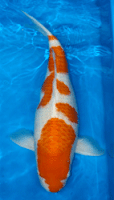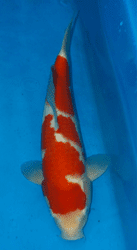
KOI FISH -- This article series designed for newbie Koi Keeper who want to start keep koi fish. About this series koi types and koi clasification designed in 4 part. Part I is this article talk about Gosanke and Bekko . Part II about Utsurimono, Asagi and Tancho. Part III about Hikarimono,Goromo And Hikarimoyo. Last Part about Matsuba and Kawarimono. Koi are beautiful fish with variety of ornamental colour.
Koi Fish are developed from the common carp fish.The hobby of Koi keeping come from Japan and has spread across the world.
People believe that keeping koi can give them hocky.it is up to you believe or not. More people like Koi because their beauty. Koi are actually color-mutated food carp.If You beginner of Koi keeper or will start keep koi you must know variety of koi type.
Each variety usually has a Doitsu (scaless Koi ) version and a Gin Rin (sparkly) scaled version. These classes are based upon the Koi's markings, colors and/or scale type. Within each of these classes there are a number of sub categories.General Clasification of Koi type are Gosanke, Shiro, Utsurimono, Asagi, Tancho, Hikarimono, Goromo, Hikarimoyo, Matsuba and Kawarimono.
But Before talk more about koi type there are Japanese terms relating to Koi. These term will help us to understand description of Koi type.
1. HI , red color only in patches
2.Sumi, black color only in patches
3.Nezu , gray color
4.Midori, green color
5.Cha, brown
6.Beni, dark red
7.Kin, gold (yellow metallic)
8.Matsuba, Pine Cone Pattern
9.Rin, shiny Scale
10. Aka red the whole fish
11.Karasu Black the whole fish
12.Shiro white
13.Ki yellow
14.Orenji orange
15.Ai indigo
16.Gin silver (white metallic)
17.Bekko Black & White
18.Doitsu German scale-less or mirror carp
Gosanke
1. Kohaku
It is said that every hobbyist's collection begins and ends the the Kohaku. The red patternis called Hi. The Hi should be thick with good edges. There are all sorts of different Kohaku patterns.Some are broken up, some are large and sweeping. Look for a pattern that doesn't go down past the eyes and and is well balanced.

The two step Kohaku pattern is called Nidan. The three step pattern is called Sandan. The four step pattern is called Yondan. The lighting strike pattern is called Inazuma.
Most people agree the the best Kohaku have three or four patterns of Hi.
2. Sanke
The Sanke look like Kohaku, but they have a black stepping stone pattern that runs
along their back. The black pattern is called Sumi. A good looking Sanke will have a good Kohaku Hi pattern. The black pattern must not show up on the head and it should not be touching the Hi. Sanke are bred by crossing a Kohaku with a Shiro Bekko.

The best sumi patterns on Sanke look like the dabs of an artist's brush. Many people have a hard time telling the the difference between a Showa and a Sanke. "How do you tell the difference?" they ask. Here are a couple of pointers:
1. Sanke do not have black on their heads, the Showa do.
2. Sanke are white Koi, with red and black patterns. Showa are black Koi, with a white and red pattern.
3.Showa
The Showa is a magnificant Koi. The white, red, and black all fit together perfectly. The beauty of this Koi is a true example of the Japanese breeder's ability to creature living works of art. A good Showa will have a nice balance of color. The pattern must be easy on the eyes and there should be sharp edges between the patterns. Showa are created by breeding a Kohaku with a Shiro Utsuri.

A cool Showa pattern is the sumi slash across the face.
Bekko
Bekko is The colored Koi with a black pattern.
Shiro Bekko
Shiro Bekko are a white skinned Koi with a black stepping stone pattern. The sumi (black) pattern on the Shiro Bekko should be balanced and have sharp edges. Having a hard time telling the difference between a Shiro Bekko and a Shiro Utsuri? Shiro Utsuri have large bands of black while Shiro Bekko have only small patches of color.

The sumi may change as the fish grows. Be careful when selecting a Shiro Bekko, look for any small black dots, these will only get worse as the Koi ages. If you have the chance, see if you can find a older brother or sister to the Koi that you are looking at and then study it to see how it has developed.
Ki Bekko
Ki Bekko are a yellow skinned Koi with a black stepping stone pattern. They are like the Shiro Bekko, but their skin color is bright yellow. The sumi (black) pattern on the Ki Bekko should be balanced and have sharp edges. Ki Bekko are somewhat rarer than its cousin, the Shiro Bekko. The sumi may change as the fish grows. Be careful when selecting a Ki Bekko, look for any small black dots, these will only get worse as the Koi ages.

If you have the chance, see if you can find a older brother or sister to the Koi thatyou are looking at and then study it to see how it has developed.
Aka Beko
Aka Bekko are a red skinned Koi with a black stepping stone pattern. They are like the Shiro Bekko, but their skin color is vibrant red.

The sumi (black) pattern on the Aka Bekko should be balanced and have sharp edges. Aka Bekko are somewhat rarer than its cousin, the Shiro Bekko. The sumi may change as the fish grows. e careful when selecting an Aka Bekko, look for any small black dots, these will only get worse as the Koi ages. If you have the chance, see if you can find a older brother or sister to the Koi that you are looking at and then study it to see how it has developed.
Reference:
1. http://www.tnaquaculture.org/
2. http://www.nishikigoi-info.com/
3. http://www.blogger.com/www.nishikigoiofniigta.com
4. http://www.bluewaterkoi.com/




0 comments:
Post a Comment